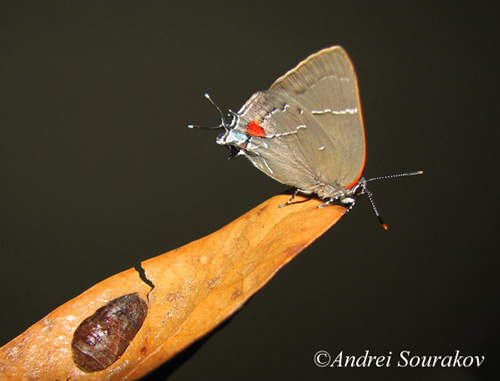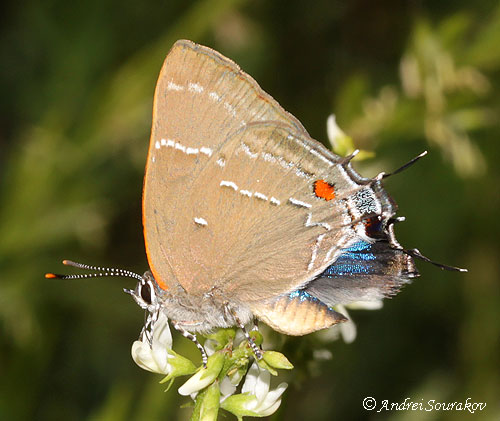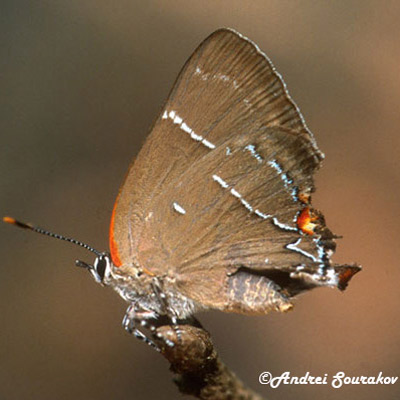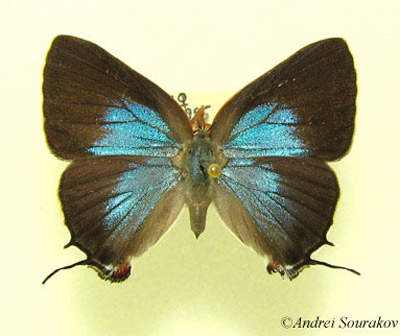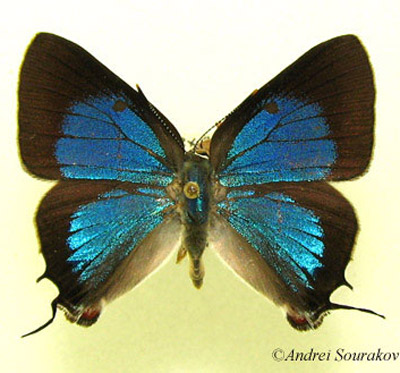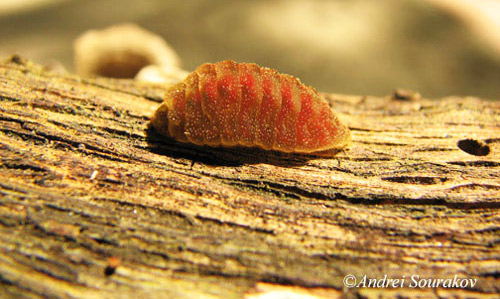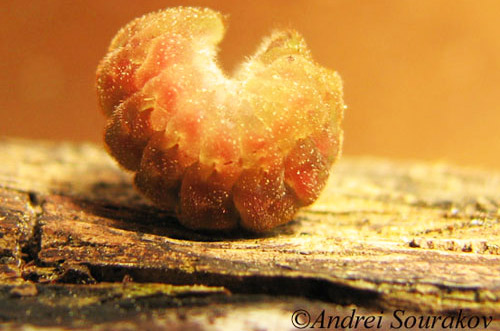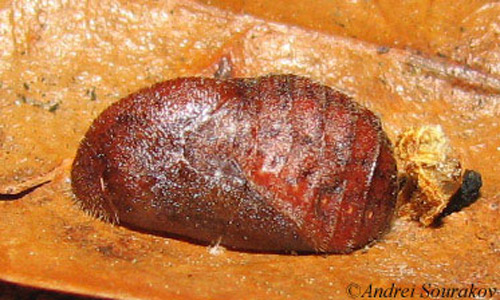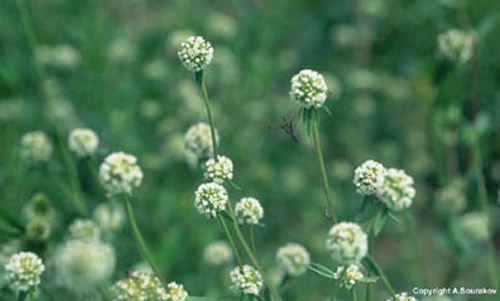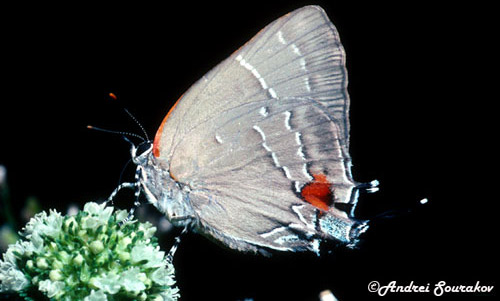common name: white M hairstreak
scientific name: Parrhasius m-album (Boisduval & LeConte) (Insecta: Lepidoptera: Lycaenidae: Theclinae)
Introduction - Distribution - Description - Life Cycle - Hosts - Selected References
Introduction (Back to Top)
The white M hairstreak, Parrhasius m-album (Boisduval & LeConte), flies in clearings and edges of oak growth.
Originally described as Thecla m-album, this beautiful metallic blue hairstreak is a typical representative of Neotropical hairstreak fauna that is occasionally found as far north as Canada. Other members of the genus (total of five) can be found from Mexico to Bolivia (Lamas 2004). The brilliant blue coloration of the upper side, similar to the famous shiny blue coloration of Morpho butterflies in the tropics is optical in nature. The characteristic M-shaped pattern on the silver-colored underside, makes this a noteworthy butterfly species, which otherwise has little economic or conservation importance.
Figure 1. Adult (upper tight) and pupa (lower left) of the white M hairstreak, Parrhasius m-album (Boisduval & LeConte). The adult's head and antennae are to the right. Cocking your head slightly to the left alows you to see the white "M" on the underside of the hindwing. Photograph by Andrei Sourakov, Florida Museum of Natural History.
The M-shaped lines on the underside hind wing lead towards a focal point of "false eye" - the red and blue spots and the "false antennae" - short wing tails with white tips. The mimicry goes even further: the hairstreak turns around when it lands in order to fool the predator about the whereabouts of its vital organs. Hence, frequently one can find individuals missing parts of the wings where the eyespot and tails were located: these individuals escape attack by the predators, such as birds (Robbins 1981). Recently it has been shown that the false head is an effective defense against jumping spiders, which are likely to have more significant impact than birds on small species of Lepidoptera (Sourakov 2013).
Figure 2. Adult white M hairstreak, Parrhasius m-album (Boisduval & LeConte), showing the effectiveness of the mimicry of the false eye and antennae. Photograph by Andrei Sourakov, Florida Museum of Natural History.
Figure 3. Adult white M hairstreak, Parrhasius m-album (Boisduval & LeConte), showing loss of the false eye and antennae, probably resulting from a predator's attack. Photograph by Andrei Sourakov, Florida Museum of Natural History.
Distribution (Back to Top)
This is mainly a tropical and southeastern U.S. species. In the U.S., it is found from Connecticut west to southeast Iowa and Missouri, south to east Texas, the Gulf Coast, and peninsular Florida. It breeds north to Pennsylvania and Ohio, but in some years strays even farther north to Michigan. The only Canadian records are from southwestern Ontario, mostly from Essex County (Point Pelee, Pelee Island and Essex), with one recent record from the Leslie Street Spit, Toronto. (Opler and Krizek 1984).
Description (Back to Top)
Adult: The adult is 1 1/4 - 1 5/8 inches (3.2 -4.1 cm). It is tailed, with the upperwings iridescent blue with black borders. The underside is grayish brown, with a white postmedian line edged with black and forming a white M (or W) near the tail, and a white spot near base of the costa. At first glance, it could be confused with the gray hairstreak. However, white M hairstreaks have an additional white mark on the leading edge of the ventral side of the hindwing, and a stronger "M" mark on the outer corner of the ventral side of the hindwing. In addition, the red-orange spot of the white M hairstreak is more inset from the wing margin than that of the gray hairstreak. In flight, a flash of brilliant blue can be seen. Typically for other hairsteaks, the hindwings are always moving vertically when at rest, adding to the "false head" effect (see Introduction) (personal observation).
Figure 4. Adult female white M hairstreak, Parrhasius m-album (Boisduval & LeConte), dorsal view. Photograph by Andrei Sourakov, Florida Museum of Natural History.
Figure 5. Adult male white M hairstreak, Parrhasius m-album (Boisduval & LeConte), dorsal view. Photograph by Andrei Sourakov, Florida Museum of Natural History.
Larva: The larva, typical of other lycaenidae, is sluggish, yellow green and covered in downy hair. There are darker green stripes and oblique bars. It turns red-brown before pupation (personal observation).
Figure 6. Larva of the white M hairstreak, Parrhasius m-album (Boisduval & LeConte). Photograph by Andrei Sourakov, Florida Museum of Natural History.
Figure 7. Larva of the white M hairstreak, Parrhasius m-album (Boisduval & LeConte). Photograph by Andrei Sourakov, Florida Museum of Natural History.
Pupa: Typical for Lycaenidae with a cryptic dark brown color. This species pupates in leaf litter. During the summer, the pupal stage lasts about 10 days (personal observation).
Figure 8. Pupa of the white M hairstreak, Parrhasius m-album (Boisduval & LeConte). Photograph by Andrei Sourakov, Florida Museum of Natural History.
Biology and Life Cycle (Back to Top)
Little is usually known about the biology of butterflies in the subfamily Theclinae, because they are scarce, mostly canopy-dwelling species that occasionally come down to feed on flowers. That is when they mostly can be collected or photographed. We know that the bright-blue coloration plays role in sexual selection in Lycaenidae in general (Lukhtanov et al. 2007). We also know that the sudden flash of blue color can scare an approaching predator.
Parrhasius m-album overwinters as a pupa. There are three generations in the north and four in Florida, from February to October.
Another species, Strymon megarus (Godart), is a pest of pineapples in South and Central America where it also attacks other bromeliads in natural habitats.
Hosts (Back to Top)
Caterpillar hosts: White oak (Quercus alba), live oak (Quercus virginiana), blackjack oak (Quercus marilandica), Shumard's oak (Quercus shumardii).
The association of theclines with larger, ecosystem dominant, tree species, such as oaks, is not unusual. Many members of the subfamily found, for example, in the Far East are large tree (including oak) feeders (e. g., Dantchenko et al. 1995).
Adult food: Nectar from a variety of flowers including viburnum, sumac, sourwood, wild plum, poinsettia, sweet pepperbush, common milkweed, lantana, dogwood, and goldenrod. Also, false buttonweed or southern Larraflower, Spermacoce verticillata, is an excellent plant to attract variety of smaller butterflies, and specifically haistreaks, to your garden (personal observation). It blooms continuously from early spring through December. This perennial does best in full sun and rich soil, but will survive in most conditions.
Figure 9. Inflorescences of Spermacoce verticillata, a wildflower. The nectar in the flowers attracts adults of the white M hairstreak, Parrhasius m-album (Boisduval & LeConte). One of the "common" names of this wildflower is shrubby false buttonweed. This plant is also called souhern Larraflower, as it is an important nectar source for Larra wasps, a significant biological control of pest mole crickets. Photograph by A. Sourakov, Florida Museum of Natural History.
Figure 10. The white M hairstreak, Parrhasius m-album (Boisduval & LeConte, feeding at an inflorescences of Spermacoce verticillata, a wildflower. One of the "common" names of this wildflower is shrubby false buttonweed. This plant is also called souhern Larraflower, as it is an important nectar source for Larra wasps, a significant biological control of pest mole crickets. Photograph by A. Sourakov, Florida Museum of Natural History.
Selected References (Back to Top)
- Dantchenko A, Sourakov A, Emmel TC. 1995. Egg structure and notes on biology of Theclinae (Lepidoptera: Lycaenidae) of Primor'e, Russian Far East. Holarctic Lepidoptera 2: 27-38.
- Lamas G, 2004 Atlas of Neotropical Lepidoptera: Checklist: Part 4A, Hesperioidea - Papilionoidea. ATL, Scientific Publishers. 439 pp.
- Lukhtanov VA, Kandul NP, Plotkin J, Dantchenko AV, Haig D, Pierce NE. 2005. Reinforcement of pre-zygotic isolation and karyotype evolution in Agrodiaetus butterflies. Nature 436: 385-389
- Opler P, Krizek G. 1984. Butterflies East of the Great Plains. John Hopkins University Press.
- Robbins RK. 1981. The "False Head" hypothesis: predation and wing pattern variation of Lycaenid butterflies. American Naturalist 118: 770-775.
- Sourakov A. 2013. Two heads are better than one: False head allows Calycopis cecrops (Lycaenidae) to escape predation by a jumping spider, Phidippus pulcherrimus (Salticidae). Journal of Natural History 47(15-16): 1047-1054. DOI:10.1080/00222933.2012.75928
- Vane-Wright PI, Ackery PR. 1984. The Biology of Butterflies, Vol. 11. Symposium of the Royal Entomological Society. London. pp. 225-244
